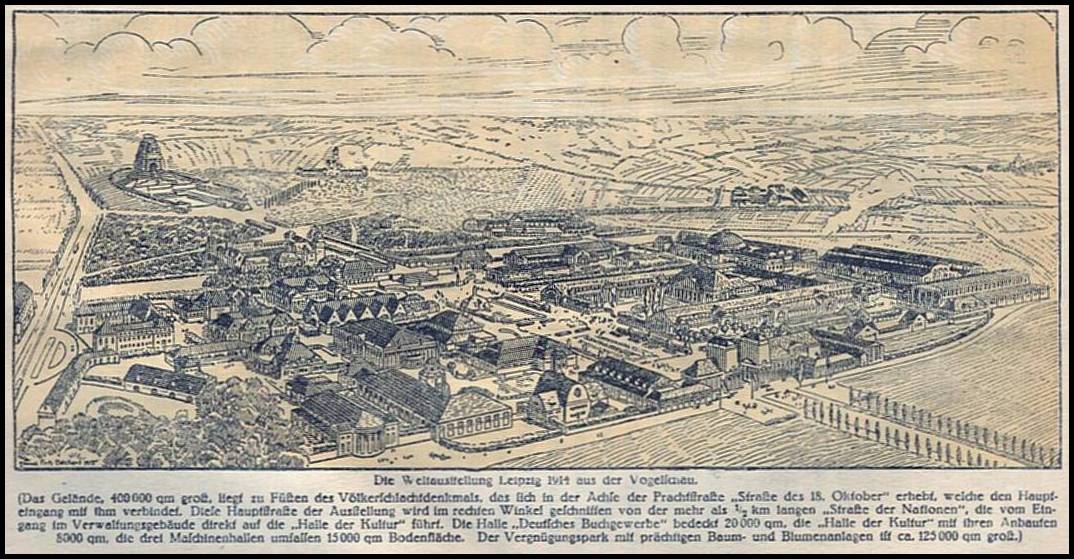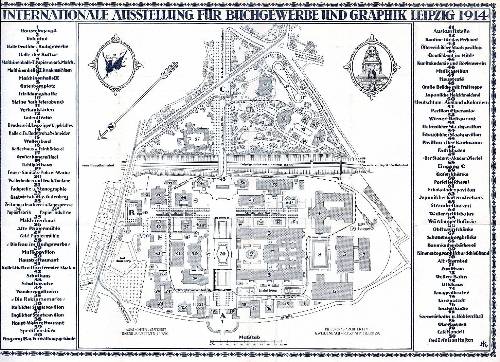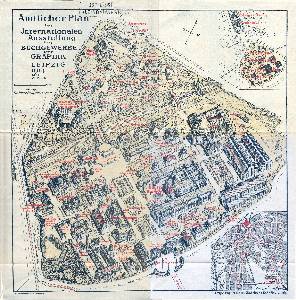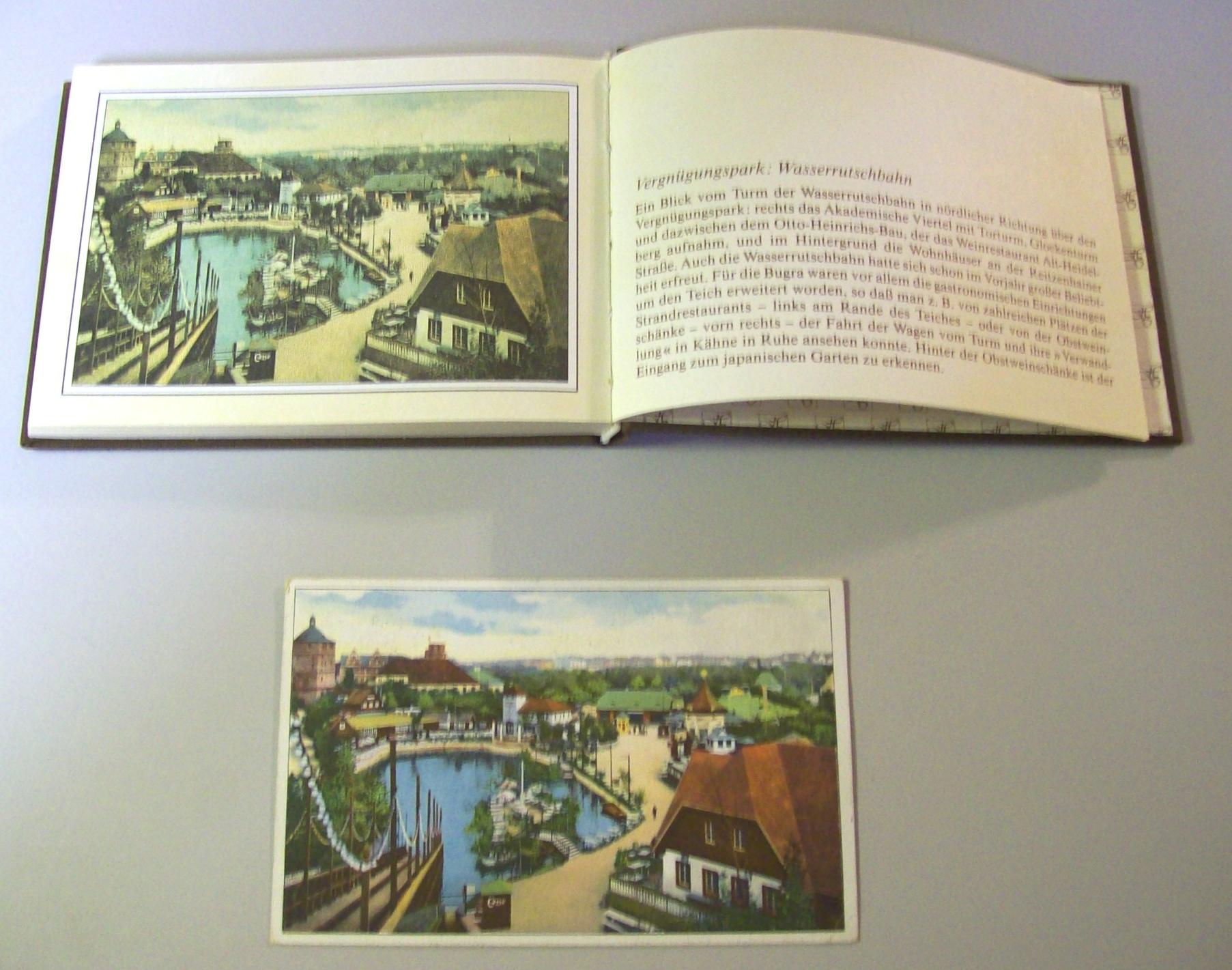Planning for the exhibition was begun in 1910, with the intent of celebrating the 150th anniversary of Leipzig's Königliche Akademie für Graphische Künste und Buchgewerbe (Royal Academy of Graphic Arts and Book Trades), as well as in recognition
of Leipzig's status as the pre-eminent book-publishing city of Germany.
The event that resulted, in 1914, was considered by all who attended it a marvel of organization, sophistication and excellence.
The grounds occupied a plot of 100 acres, and were part of the site of the Battle of Leipzig (Oct. 16-19, 1813),
in memory of which there had been recently dedicated a huge Battle Memorial, which stood prominently at one side
of the area. One can gain a better idea of the size and scope from the illustration below, a birds-eye view of the exhibition. That's the battle memorial in back at the far left.

Looking southeast - the Leipzig main train station (and central Leipzig) is about two miles northwest of the monument, so directly behind the viewer here.
HERE is an aerial view of central Leipzig looking towards the monument a year earlier.
100 acres may not seem large, especially compared to other world expos of the time - the Panama-Pacific Expo in San
Francisco the following year, 1915, occupied a site of 635 acres. But considering the limited scope of the topic,
the Bugra was quite large. Its grounds included over 40 structures, six of them built by foreign countries (England,
France, Italy, Austria, Japan and Russia). Seven other nations erected exhibits in a joint pavilion - they were
Netherlands, Switzerland, Denmark, Sweden, Belgium, Spain and Norway. Six other nations, including
Portugal, Hungary, China, Korea and India - a total of twenty-two in all - had exhibits in other buildings of the expo.
The United States chose not to participate, except for an exhibit by the ALA in the library section.
This was a source of distress to the organizers, and to the German government, since Germany had participated
in several US expos, and the US had never exhibited at any German ones.
I found online a digitized version of the May 14, 1914 report of the head of the ALA delegation to the Bugra
(IMPRESSIONS OF THE LEIPZIG EXPOSITION, By Theodore W. Koch, Librarian, University of Michigan),
which you can download HERE.
It contains an interesting account of the expo itself, as well as the ALA exhibit, and the writer's impressions of it all.
Also, HERE is a pdf of a July 26, 1914 article from the New York Times about the Bugra.
Sadly, the exposition was cut short by the outbreak of World War I in early August. All the foreign exhibitors packed their
exhibitions for later shipment (most were returned after the War), and ran for home. I don't know whether the rest of the exhibition remained open until its official closing date or not.
07/12/2010 - I just received a book titled
"Amtliche Führer durch die Internationale Ausstellung für Buchgewerbe und Graphik",
the official guidebook to the exhibition. It includes this map of the grounds.

Note that number 35 is "Die Reklamemarke" - German
for "Poster Stamp" - that's the first place I would have stopped. And my second stop would be number 61,
the Chocolate Pavilion! Not that I wouldn't want to see all the exhibits, but I have my priorities.
07/19/2010 - I just received this "Amtlicher Plan" (Official Map) of the Bugra!

Unlike the first map, this one shows how each building looked, and the labels are right on them. Very nice.
"Bugra-Ansichten: Historische Bilder der Internationalen Ausstellung für Buchgewerbe und Graphik, Leipzig 1914"
This charming little book was published in 1988. It reproduces many of the Bugra postcards, and extols the wonders of the exhibition.
I got my copy on eBay recently. It shows up there from time to time, and there are usually copies available thru Abebooks and Amazon.


Finally, below are thumbnails of scans of a pamphlet (in German) about the Bugra.
Click on any of them to open a new page with a full-size view. Use the arrows
on the full-size views to move forward or backward through the pages.



